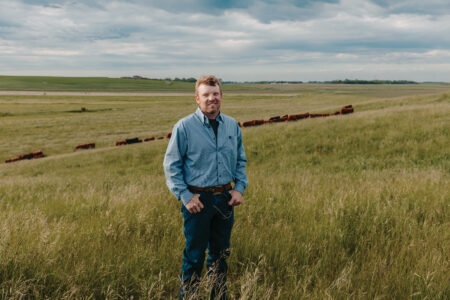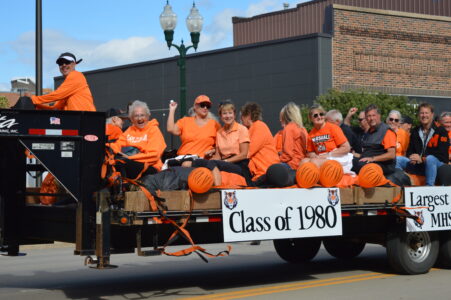Remembering a deadly tornado
Tracy residents gathered Saturday to mark the 50th anniversary of the tornado that ripped through their town

Photo by Deb Gau Tracy native Scott Thoma released a total of nine balloons — one for each of the 1968 Tracy tornado’s victims — during a memorial ceremony Saturday. For more photos from the ceremony, turn to page 8A.
TRACY — The morning turned out rainy — too wet for outdoor events at Tracy’s Central Park. But inside nearby Tracy Lutheran Church, a crowd had gathered for lunch and to mingle with both past and current Tracy residents. And around noon, people stood under umbrellas near the corner of Rowland and Park Street as Scott Thoma released nine black balloons, one by one.
The church bell rang nine times, once for each of the nine people killed by the tornado that truck Tracy on June 13, 1968. With each chime, Thoma released one balloon, until the crowd was left watching the balloons rise into the sky and drift southward.
“When you could see them going far away, that got emotional,” Thoma said of the balloon release. Thoma, a Tracy native, organized the event to help honor the tornado’s victims.
The balloon release was one of the focal events Saturday at a commemoration of the 50th anniversary of the Tracy tornado. People gathered for a community lunch, a bake sale, a silent auction and a quilt raffle in Tracy. Thoma said all those events were intended to raise funds for memorial scholarships in each of the nine tornado victims’ names. On Saturday afternoon, KSTP-TV meteorologist Jonathan Yuhas gave a talk about how tornadoes form.
More than 100 people gathered at the Caboose to hear Yuhas speak. Besides answering questions about storms and tornadoes, Yuhas was able to share footage of KSTP’s 1968 news broadcast covering the Tracy tornado. The report said the tornado cut a path of destruction through town that was 1.5 miles long and three blocks wide. A total of 110 homes were destroyed.
Yuhas pointed out how the Tracy residents in the news footage were wearing warm clothing and coats. Southwest Minnesota is an area where cold arctic air can meet hot, humid air, creating conditions ripe for storms, he said.
“Tornado Alley extends almost from where we are in Tracy, down to northern Texas, Oklahoma and Kansas,” he said.
Yuhas also talked about what tornadoes and the storms that form them look like.
“What causes the green color (in the sky)?” asked an audience member.
“The green color is actually from hail,” Yuhas said. The kind of storms capable of producing tornadoes can also produce hail. When sunlight refracts through the hail in the storm clouds, it can make the light look green, he said.
Sharing memories, both of Tracy and the tornado, was a big part of Saturday’s gathering. Some of the people present were returning to Tracy to meet up with family. On Saturday morning, Kay Radke and Sharlene Neal stopped by the tornado memorial near Highway 14 and snapped a few photos. Their grandmother, Ella Haney, was one of the people whose names are engraved on the memorial.
“Our grandmother was killed, and our folks lost their place,” Radke said of the tornado.
Radke and Neal remembered the devastation the tornado caused. Returning to Tracy in the first few years after the tornado was eerie, Neal said, because so many trees were gone.
Rita Forbregd and Norine Hanson said their family was able to take shelter in their basement before the tornado hit.
“We all went downstairs quick,” Forbregd said. “(My mother) knew what was happening, because she had been in a tornado as a kid.”
Forbregd and Hanson said the tornado destroyed the house above them.
“My story is, the tornado started to take me up, and my parents held me down,” Hanson said.
Forbregd described the sound as the tornado passed over them.
“It’s as loud as everyone says it is,” she said.
“I think afterwards, we were all in shock,” Forbregd said. There were some strange things they found in the tornado’s aftermath. A packed crate of china from a neighbor’s house ended up in their basement, Forbregd said. “Not a dish had been cracked.”
The Tracy tornado was preceded by a storm, residents remembered.
“All of a sudden it started raining, and then all of a sudden it started hailing,” said Clint Peterson, who was Tracy High School’s band instructor in 1968.
Willis Mattison, a teacher at Tracy High School in 1968, said his family was having neighbors over for a cookout when the storm hit. After the hail, Mattison said, “You would’ve thought it was over, except the sky was this red-orange color.”
Besides the ominous color in the sky, Mattison said, he and a neighbor saw what looked like a cloud approaching. There were birds trying to escape the cloud but getting pulled back in, he said. Then, he said, they saw walls from trailers not far from the house, “just jumping up into the sky,” Mattison said.
Mattison, his family and the neighbors took shelter in the basement. After the tornado had passed, he joined the response efforts as a member of Tracy’s auxiliary police. Mattison got into one of the town’s squad cars.
“I didn’t drive more than six or eight blocks, and I had four flat tires,” he said.
Ron McDaniel described seeing the tornado along with his Legion baseball teammates, as they were riding a bus from Cottonwood home to Tracy. Their game that day had been called, due to hail. When the bus got closer to town, he said, it was clear the tornado hit Tracy.
“You could see the gaping hole right through town,” McDaniel said.
Tornado survivors also remembered the people who came to Tracy after the tornado — volunteers who helped residents and worked to clean up the town. One of Mattison’s high school students, Greg Von Bokern, also played an important role in responding to the tornado. Von Bokern was a ham radio operator, and using power from the Tracy hospital’s emergency generator, he served as Tracy’s communications link with the outside world in the days after the tornado, Mattison said.
Sue (Lindstrom) Roepke said it might be emotionally difficult to remember the tornado. Many people lost homes, neighbors or family members.
“On the block where I grew up, there were two people who died,” Fred Pilatus and Otelia Werner, Roepke said.
But, she said, remembering was still important. The anniversary was “A day to remember these nine people who passed, and the people who helped.”


